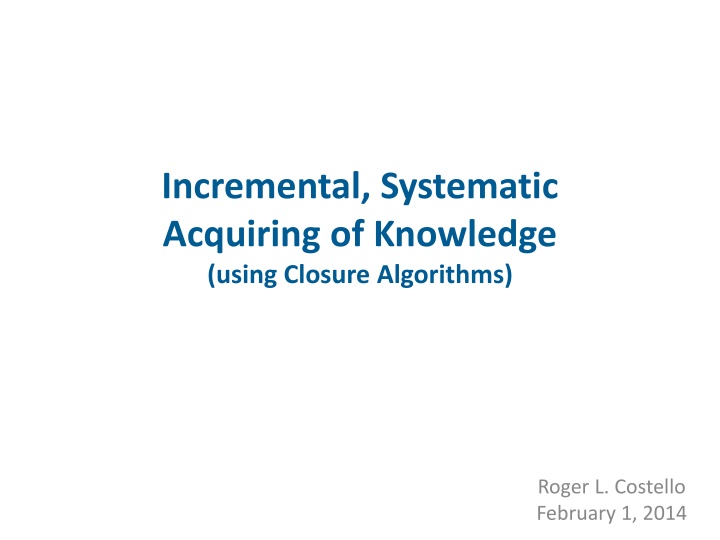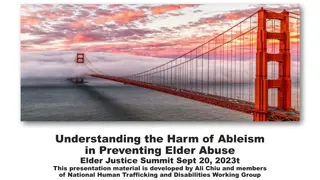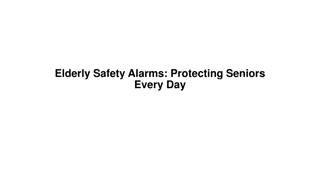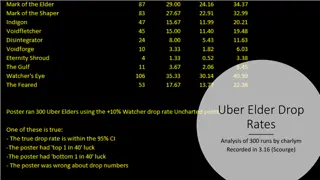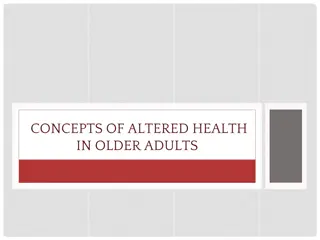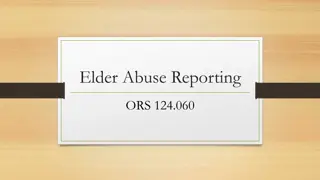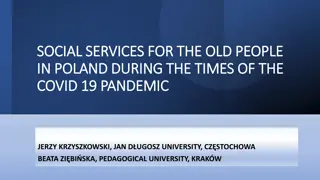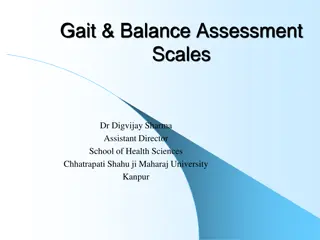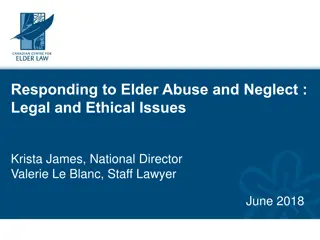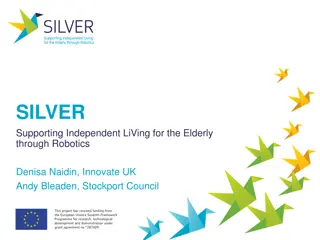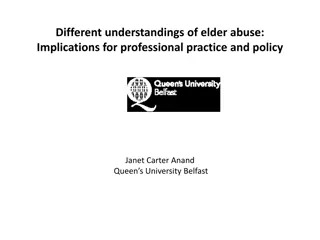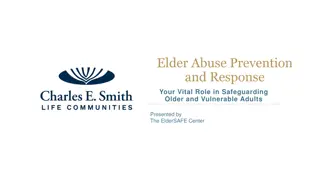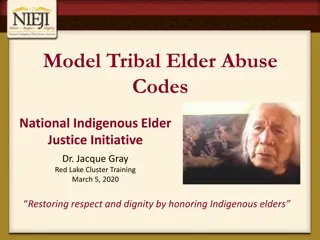Central Boston Elder Services: Protecting Elderly in Boston
Central Boston Elder Services offers the Elder Protective Services Program, intervening in situations of self-neglect, abuse, and neglect endangering the health and well-being of elderly individuals over 60 in Boston. The program serves those in the community with allegations made by the individual or known persons, aiming to address various forms of abuse and exploitation. Reporting can be done by anyone in the community, with professionals mandated to report cases. Consultation and reporting processes are detailed for individuals seeking assistance.
Download Presentation

Please find below an Image/Link to download the presentation.
The content on the website is provided AS IS for your information and personal use only. It may not be sold, licensed, or shared on other websites without obtaining consent from the author.If you encounter any issues during the download, it is possible that the publisher has removed the file from their server.
You are allowed to download the files provided on this website for personal or commercial use, subject to the condition that they are used lawfully. All files are the property of their respective owners.
The content on the website is provided AS IS for your information and personal use only. It may not be sold, licensed, or shared on other websites without obtaining consent from the author.
E N D
Presentation Transcript
Incremental, Systematic Acquiring of Knowledge (using Closure Algorithms) Roger L. Costello February 1, 2014
Problem Statement Problem: What cities can you get to from Boston? <Flights> <Flight> <From>Boston</From> <To>Miami</To> </Flight> <Flight> <From>Miami</From> <To>Houston</To> </Flight> <Flight> <From>Cleveland</From> <To>Akron</To> </Flight> <Flight> <From>Boston</From> <To>Denver</To> </Flight> </Flights> It is easy to eyeball this sample XML and see that from Boston you can get to Miami, Houston (via Miami), and Denver. But if the XML document had thousands of flights, it would be impossible to eyeball it to get the answer. 3
Need a Strategy We need a systematic, incremental approach to obtaining the answer. That s what closure algorithms give us. 4
Closure algorithms A closure algorithm enables the incremental, systematic acquiring of knowledge. Closure algorithms are characterized by two components: An initialization, which is an assessment of what we know initially. An inference rule, which is a rule telling how knowledge from several places is to be combined. The inference rule(s) are repeated until nothing changes any more. 5
Initial Knowledge This is what we know initially: All the flights From Boston we can get to Miami and Denver since there are direct flights to those cities. <Flights> <Flight> <From>Boston</From> <To>Miami</To> </Flight> <Flight> <From>Miami</From> <To>Houston</To> </Flight> <Flight> <From>Cleveland</From> <To>Akron</To> </Flight> <Flight> <From>Boston</From> <To>Denver</To> </Flight> </Flights> 6
Inference Rule If we can get to the city identified in <From>, then we can get to the city identified in <To>. 7
Initial knowledge Go through the XML and for each <Flight> with a direct flight from Boston, mark it as Can get there from Boston . Flight Can get there from Boston? <Flight><From>Boston</From><To>Miami</To></Flight> Yes <Flight><From>Miami</From><To>Houston</To></Flight> <Flight><From>Cleveland</From><To>Akron</To></Flight> <Flight><From>Boston</From><To>Denver</To></Flight> Yes 8
Build on top of our knowledge Apply the inference rule to gain more knowledge. This is round two (round one was marking the initial knowledge). Flight Can get there from Boston? <Flight><From>Boston</From><To>Miami</To></Flight> Yes <Flight><From>Miami</From><To>Houston</To></Flight> Yes (since we can get to Miami) <Flight><From>Cleveland</From><To>Akron</To></Flight> <Flight><From>Boston</From><To>Denver</To></Flight> Yes 9
Round Three A third round yields no additional cities. Flight Can get there from Boston? <Flight><From>Boston</From><To>Miami</To></Flight> Yes <Flight><From>Miami</From><To>Houston</To></Flight> Yes <Flight><From>Cleveland</From><To>Akron</To></Flight> <Flight><From>Boston</From><To>Denver</To></Flight> Yes 10
Problem/Answer Problem: What cities can you get to from Boston? Answer: We can get to these cities: {Miami, Denver, Houston} 11
<xs:schema xmlns:xs="http://www.w3.org/2001/XMLSchema"> <xs:element name="Document"> <xs:complexType> <xs:choice> <xs:sequence> <xs:element ref="A" /> <xs:element ref="B" /> </xs:sequence> <xs:sequence> <xs:element ref="D" /> <xs:element ref="E" /> </xs:sequence> </xs:choice> </xs:complexType> </xs:element> <xs:element name="A" type="xs:string" /> <xs:element name="B"> <xs:complexType mixed="true"> <xs:sequence> <xs:element ref="C" /> </xs:sequence> </xs:complexType> </xs:element> <xs:element name="C" type="xs:string" /> <xs:element name="D"> <xs:complexType mixed="true"> <xs:sequence> <xs:element ref="F" /> </xs:sequence> </xs:complexType> </xs:element> <xs:element name="E" type="xs:string" /> <xs:element name="F"> <xs:complexType mixed="true"> <xs:sequence> <xs:element ref="D" /> </xs:sequence> </xs:complexType> </xs:element> Clean XML Schema Problem: Are there any element declarations in the adjacent XML Schema that, if used, do not result in a valid XML instance document (e.g., perhaps because they loop infinitely)? In other words, are there any non-productive element declarations? 13 </xs:schema>
Concise Notation For brevity, let s depict the element declarations this way: Document A B | D E A string B stringC C string D d F E string F string D A string means the value of element A is a string. B string C means the value of element B is a string and a child element C (i.e., B has mixed content). 14
Terminology Document A B | D E A string B stringC C string D d F E string F string D These are rules. Each rule has a left-hand side and a right-hand side (the two sides are separated by an arrow ). Document, A, B, , F are non-terminal symbols. string is a terminal symbol. 15
Find the productive rules We find the non-productive rules by finding the productive ones. A rule is productive if its right-hand side consists of symbols all of which are productive. Symbols that are productive: Terminal symbols are productive since they produce values. A non-terminal is productive if there is a productive rule for it. 16
Initial knowledge Go through the grammar and for each rule for which we know that all its right-hand side members are productive, mark the rule and the non-terminal it defines as productive . Rule Document A B Document D E A string B stringC C string D string F E string F string D Is it productive? Yes Yes Yes 17
Build on top of our knowledge Apply the inference rule to gain more knowledge. Rule Document A B Document D E A string B stringC C string D string F E string F string D Is it productive? Yes Yes (since string and C are productive) Yes Yes 18
Round three Rule Document A B Document D E A string B stringC C string D string F E string F string D Is it productive? Yes (since A and B are productive) Yes Yes (since string and C are productive) Yes Yes 19
Round four A fourth round yields nothing new. Rule Document A B Document D E A string B stringC C string D string F E string F string D Is it productive? Yes (since A and B are productive) Yes Yes (since string and C are productive) Yes Yes 20
Recap We now know that Document, A, B, C, and E are productive and D, F, and the rule Document DE are not productive. Rule Document A B Document D E A string B stringC C string D string F E string F string D Is it productive? Yes (since A and B are productive) Yes Yes (since C is productive) Yes Yes 21
Remove non-productive rules We have pursued all possible avenues for productivity, and have not found any possibilities for D, F, and the second rule for Document. That means the rules for D, F, and the second rule for Document can be removed from the XML Schema. Rule Document A B A string B stringC C string E string Is it productive? Yes (since A and B are productive) Yes Yes (since C is productive) Yes Yes The XML Schema after removing non-productive rules 22
Cleaned XML Schema Problem: Does the XML Schema have any non- productive element declarations? Answer: Yes, and the cleaned XML Schema is shown in the adjacent box. <xs:schema xmlns:xs="http://www.w3.org/2001/XMLSchema"> <xs:element name="Document"> <xs:complexType> <xs:sequence> <xs:element ref="A" /> <xs:element ref="B" /> </xs:sequence> </xs:complexType> </xs:element> <xs:element name="A" type="xs:string" /> <xs:element name="B"> <xs:complexType mixed="true"> <xs:sequence> <xs:element ref="C" /> </xs:sequence> </xs:complexType> </xs:element> <xs:element name="C" type="xs:string" /> <xs:element name="E" type="xs:string" /> </xs:schema> 23
Bottom-up process Removing the non-productive rules is a bottom-up process: only the bottom level, where the terminal symbols live, can we know what is productive. 24
Why is it called closure? We have seen two examples where new knowledge was incrementally, systematically acquired using a closure algorithm. Question:Where does the term closure come from? Answer: Applying the inference rule yields knowledge about existing symbols, without going outside the universe of discourse. In the last example, applying the inference rule resulted in new knowledge about the elements that are productive in the XML Schema. Conversely, say the inference rule were to result in knowledge about elements in a completely different XML Schema, then the algorithm would not be closed. In a closure algorithm the universe of discourse is self- contained, no information outside of the universe is generated. 25
Acknowledgement Some of the information in these slides come from this fabulous book: Parsing Techniques by Dick Grune and Ceriel Jacobs.X 26
